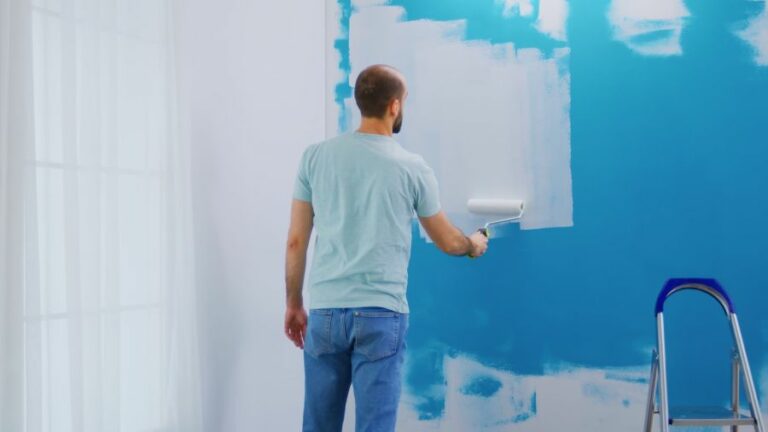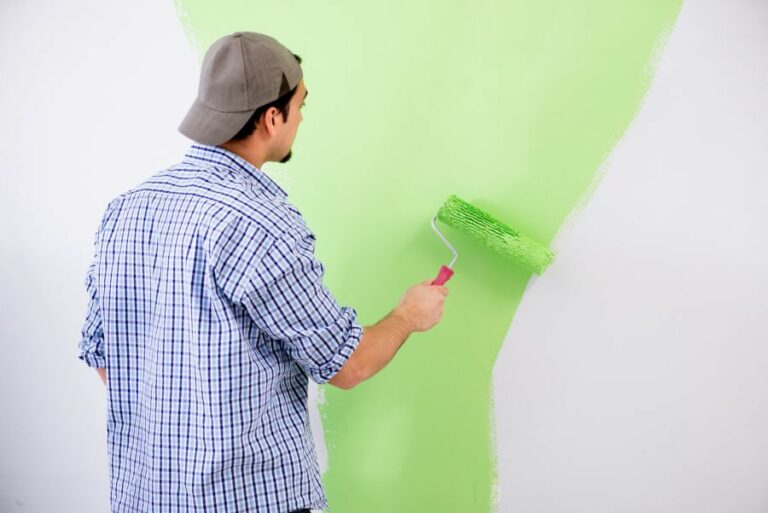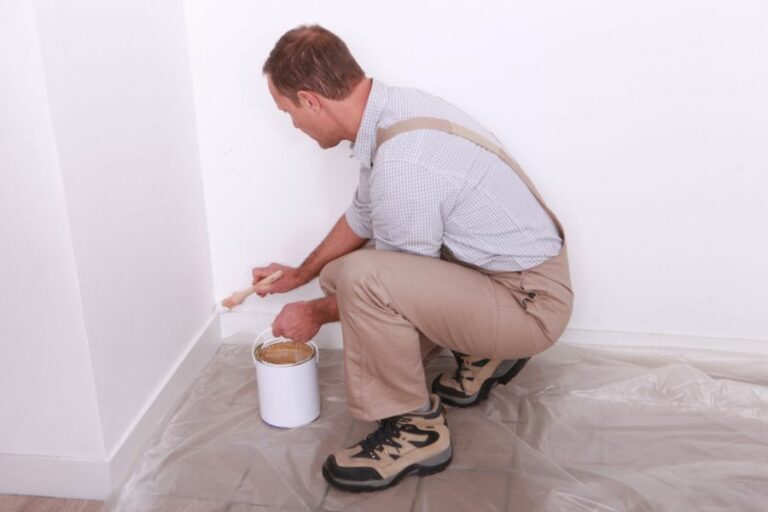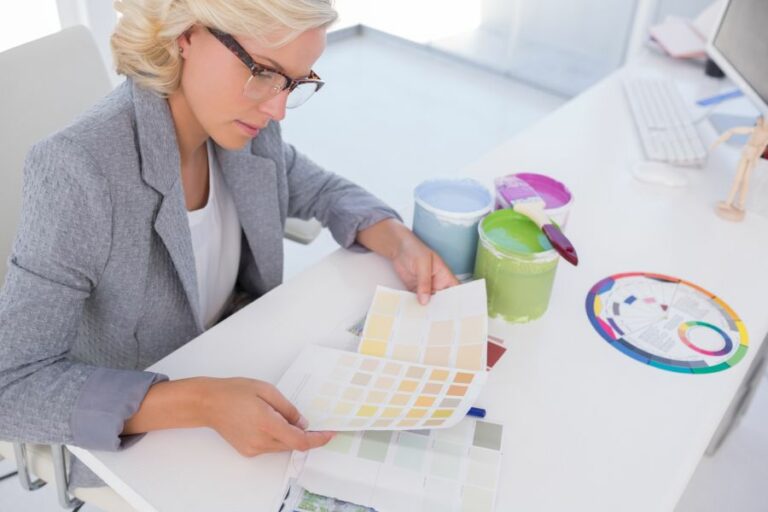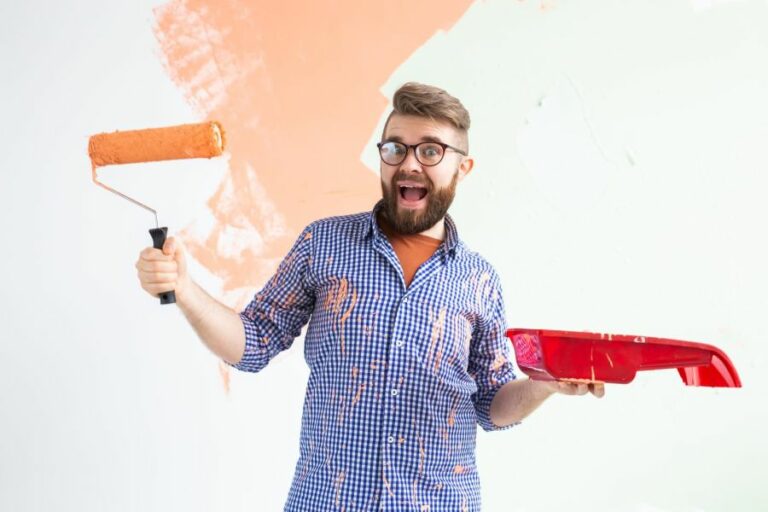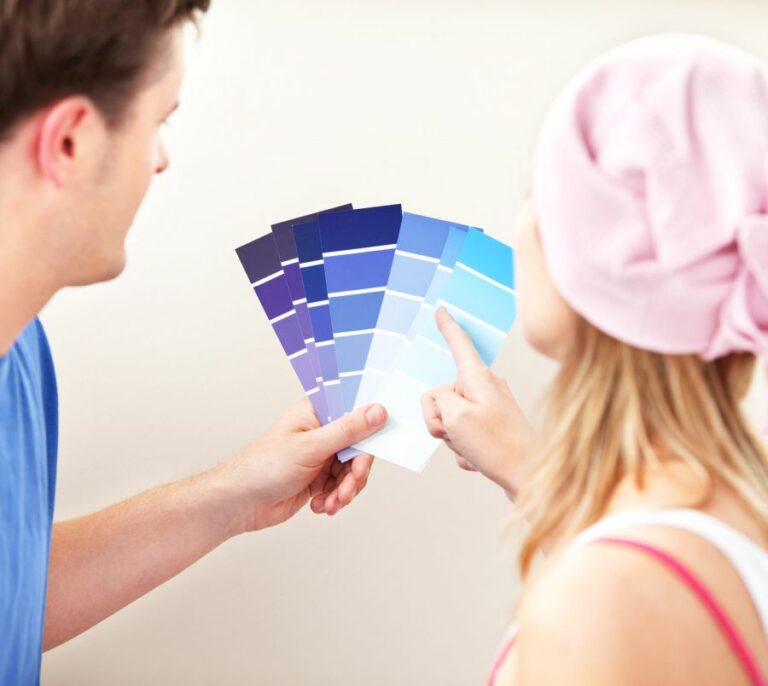Indoor Paint Textures – Informative. What Pros Say
Are you planning a home makeover and feeling overwhelmed with the variety of paint textures available for your interiors? We are here to simplify and guide you through the world of indoor paint textures. With our expertise in the field, we assure you a beautiful transformation tailored to your tastes without breaking the bank.
Indoor paint textures – informative:
Indoor paint textures include a smooth finish, orange peel texture, knockdown texture, sand texture, and Venetian plaster. Each texture offers a unique appearance for interior design, with techniques requiring proper surface preparation, quality paints, and appropriate application methods. Some complex textures, like Venetian plaster, may require professional consultation.

Discover a variety of indoor paint textures that can transform your walls and elevate your home’s aesthetic. Continue reading to learn about different textures, application techniques, and tips for a professional finish that you’ll love! Don’t miss out on these creative insights!
Contents
- 1 Interior Paint Textures: A Comprehensive Guide
- 2 Choosing the Perfect Paint Texture for Your Home Interior
- 3 Exploring Various Types of Paint Textures
- 4 Popular Paint Textures: Discover the Top Choices
- 5 Textured Paint: The Pros and Cons Revealed
- 6 Identifying the Different Types of Textured Paint
Interior Paint Textures: A Comprehensive Guide
• Introduction to Textures in Paint
Indoor paint textures are essential to interior design and can create unique finishes and appearances within a home or commercial space.
• Types of Indoor Paint Textures
– Smooth Finish
A smooth finish is the most common texture that is found in most homes. It’s characterized by a flat, even surface with no noticeable bumps, ridges, or imperfections.
To achieve a smooth finish, use high-quality paint and apply it with a roller or a brush. It’s important to properly prepare the surface by cleaning it and filling any holes, cracks, or imperfections with a suitable filler.
After applying the first coat of paint, allow it to dry completely, and then lightly sand the surface before applying a second coat.
– Orange Peel Texture
As the name suggests, the orange peel texture resembles the surface of an orange peel. This texture is achieved with a spray gun and is typically used in large commercial spaces or residential properties with high ceilings and walls.
To create this texture, first, dilute the paint with water or a paint thinner, then use a spray gun to apply multiple thin coats. It’s essential to maintain a consistent distance between the spray gun and the wall to ensure an even finish. For a more pronounced texture, use heavier paint or apply additional layers.
– Knockdown Texture
A knockdown texture is similar to an orange peel texture but with more visual depth and dimension. This finish can hide imperfections on walls and ceilings and provide a unique, rustic charm to living spaces.
To create a knockdown texture, first, apply a texture spray to the entire surface. Then, use a wide-knife putty knife or specialized knockdown tool to smooth over and “knock down” the textured peaks. It’s essential to work quickly, as the texture will begin to set and harden.
– Sand Texture
A sand texture creates a rough, abrasive finish that is perfect for rooms with an earthy, natural aesthetic. The texture is achieved by adding fine sand to the paint or using a premixed paint containing sand.
To apply the sand texture, use a roller to apply the paint to the surface in a uniform layer. Keep in mind that some premixed sand paints may require additional stirring to ensure that the sand is evenly distributed throughout the paint.
– Venetian plaster
The Venetian plaster finish is a sophisticated and luxurious texture that recreates the appearance of polished marble or limestone. This effect is achieved by applying multiple layers of a specialized plaster mixture and is typically found in high-end residences, hotels, and restaurants.
To create a Venetian plaster finish, follow the manufacturer’s instructions for preparing and applying the product. Generally, this will involve applying a base coat followed by several layers of tinted plaster. Each layer should be applied in crisscross strokes using a trowel and then polished once dried.
• Tips and Recommendations
- Always ensure that the surface is properly prepped and clean before applying any paint or texture. Remove dust, dirt, and debris, and repair any imperfections such as holes, dents, or cracks.
- Use high-quality paints and materials to guarantee an even and durable finish. Cheap or low-quality products are more likely to produce inconsistent results and may not last as long.
- Practice the chosen texture technique on a spare piece of drywall or cardboard to familiarize yourself with the process and ensure consistent results.
- In some cases, professional help may be necessary to achieve the desired texture, particularly for complex finishes such as Venetian plaster. Consult with a professional painter or interior designer for guidance and assistance.
• Conclusion
Indoor paint textures allow for a diverse range of finishes and appearances, creating distinct and memorable spaces. By understanding the various texture options and techniques, anyone can achieve a professional and stylish finish in their home, office, or commercial space.
Choosing the Perfect Paint Texture for Your Home Interior
One of the most crucial decisions one has to make when designing or renovating an interior is determining which paint texture to use. Selecting the correct texture not only contributes to the aesthetic appeal of the space but can also impact durability, ease of cleaning, and overall ambiance.
• Types of Paint Textures
– Smooth Finish
A smooth, even finish is the most common texture used for interior walls in residential homes. This texture affords a sleek, streamlined look that is easy to clean and maintain. To achieve this finish, it is important to properly prep your surface by sanding walls and using a high-quality primer.
– Orange Peel
As the name suggests, the orange peel texture resembles the skin of an orange. It is created by applying a thin layer of joint compound to the wall, followed by spraying a mixture of thin paint and water and then leaving it to dry. This texture adds dimension to walls and has gained popularity in recent years.
– Knockdown
The knockdown texture is achieved by applying a thick layer of joint compound, allowing it to dry partially, and then using a textured roller or trowel to “knock down” the raised areas. This results in a more subtle and natural texture, reminiscent of stucco.
– Skip Trowel
A skip trowel texture is similar to a knockdown texture but requires a more skilled hand. It involves applying a very thin layer of joint compound using a trowel in a random pattern, resulting in a
Mediterranean-style finish. This texture can create a stunning and unique look when used in the right setting.
– Popcorn
Once popular in the ’70s and ’80s, popcorn textures have fallen out of favor for most interior design projects due to their tendency to collect dust and difficulty in cleaning. The texture is created by spraying a mixture of paint, water, and a coarse compound that creates a bumpy, popcorn-like appearance.
While not recommended for most interiors, it can still be found in some older homes.
• Selecting the Right Finish
The finish of an interior paint texture is the sheen or surface shine it displays. Each type of finish carries distinct characteristics that may influence your choice for your project.
– Matte / Flat Finish
A matte or flat finish has no shine or reflective qualities, which makes it ideal for hiding imperfections and creating a modern, minimalist look. This finish is best suited for low-traffic areas such as bedrooms, ceilings, or formal living spaces since it can be less durable and resistant to stains than other finishes.
– Eggshell
An eggshell finish has a slight sheen, similar to an eggshell. It offers greater durability and stain resistance than matte finishes, making it ideal for hallways, living rooms, or offices. Its understated shine also helps to accentuate architectural details or focal points in a room.
– Satin
A satin finish has a moderate sheen, creating a balance between durability and subtle shine. It is a popular choice for kitchens, bathrooms, and other high-traffic or moisture-prone areas, as it is easier to clean and resists staining.
– Semi-gloss / Gloss
A semi-gloss or gloss finish offers the highest level of sheen and reflects the most light, making it ideal for highlighting architectural features, trim work, or cabinetry.
However, highly reflective surfaces can also accentuate imperfections, so it is essential to execute proper surface preparation when using these finishes.
• Summary and Recommendations
To determine the best paint texture for your interior, consider factors such as aesthetics, functionality, and durability. For a sleek, contemporary look, a smooth finish is an ideal choice, while a texture such as orange peel or knockdown can create a more dynamic, interesting effect.
When deciding on a finish, weigh the balance between durability and sheen. Matte finishes provide minimal shine and excel at hiding imperfections, while satin and semi-gloss finishes offer increased durability and a reflective appeal.
Finally, consult resources such as The American Society for Testing and Materials (ASTM), which provides guidelines and standards for various types of paint products and application methods, to ensure you are using high-quality materials and techniques.
With proper planning, research, and execution, your interior paint project will have a beautiful and lasting impact on your living space.
Paint Texture | Advantages | Disadvantages |
|---|---|---|
Flat/Matte | Hides imperfections, easy touch-ups, minimal glare | Not easy to clean, marks easily |
Eggshell | Some washability, hides imperfections, slightly more durable | Not as easy to clean as higher-sheen finishes |
Satin | Easier to clean, good for high-traffic areas, durable | Shows imperfections, touch-ups can be more noticeable |
Semi-Gloss | Easy to clean, durable, good for high-moisture areas | Shows imperfections, not ideal for large areas like walls |
Gloss | Highly washable, durable, best for trim and furniture | Shows imperfections, not recommended for walls |
Exploring Various Types of Paint Textures
When it comes to painting, texture plays a crucial role in the final appearance of your artwork or interior design project.
• Smooth Paint Textures
– Matte
Matte paint provides a smooth finish without any shine or reflection. It is a popular choice for walls and ceilings and works well in areas where low light reflection is desired. Matte paint is easy to apply with a brush, roller, or spray gun.
One notable characteristic of matte paint is its ability to hide small imperfections on the painted surface. Be sure to use a good-quality primer before applying matte paint for the best results.
– Satin
Satin paint has a smooth texture with a slight sheen. This finish is more durable than matte and is suitable for walls in high-traffic areas. Satin finishes are also ideal for trim work and doors, as they are easy to clean and maintain.
To achieve an even satin finish, apply multiple thin coats of paint, allowing each layer to dry completely before applying the next.
– Semi-Gloss
Semi-gloss paint offers a smooth texture with a more pronounced shine than satin finishes. It is a popular choice for trim work, doors, and kitchen or bathroom walls due to its durability and ease of cleaning.
To obtain a beautiful semi-gloss finish, sand the surface with fine-grit sandpaper and clean it thoroughly before application. Use a high-quality primer and apply several thin coats of semi-gloss paint to achieve the desired finish.
• Textured Paint Finishes
– Stipple
Stipple paint creates a subtle, sand-like texture on the painted surface. It is an excellent choice for hiding minor wall imperfections and adding visual interest to a room. To achieve a stipple finish, use a specialized stipple brush or roller with rounded bristles.
After applying a base coat of paint, dip the brush in the paint and lightly dab it on the surface in random patterns. Be sure to maintain a consistent texture throughout the area being painted.
– Suede
Suede paint creates a soft, velvety texture that resembles suede fabric, giving your walls a luxurious and sophisticated look. This texture is perfect for accent walls or smaller rooms, as it adds depth and visual interest. To apply suede paint, you will need a specialized suede paint and brush or roller.
Follow the manufacturer’s instructions carefully and use a crisscross or random painting technique to achieve the desired effect.
– Knockdown
A knockdown texture is a popular choice for walls and ceilings, as it adds character to a room while hiding imperfections. This texture is achieved by applying a coat of joint compound or specifically-formulated knockdown paint with a trowel.
The compound is then knocked down with a wide-blade trowel or a knockdown knife, creating a subtle, uneven texture.
• Applying Texture with Specialized Tools
– Paint Rollers
Textured paint rollers are designed with raised patterns, allowing you to create unique textures on your walls. These specialized rollers are available in various styles, including brick, stone, and geometric patterns.
To use a textured paint roller, apply a thick layer of paint to the wall, then roll the patterned roller over the surface to create the desired texture.
– Trowels
Trowels, frequently utilized in decorative plaster applications, can also be used to create textures with thicker paint, joint compound, or specific texture paints.
By applying the material with different angles and pressures on the trowel, you can create a wide range of textures, from subtle patterns to deep swirls or ridges.
• Tips for Experimenting with Paint Textures
When considering experimenting with paint textures, follow these suggestions to ensure the best outcome:
- Test your chosen texture technique on a piece of scrap material or an inconspicuous area first.
- Practice your technique until you achieve consistency and are comfortable with the process.
- Ensure that your surface is clean, dry, and primed to achieve optimal results.
- Use high-quality paints and tools for the best finish and longevity of your project.
By understanding different paint textures and their applications, you can transform your painting project and create a visually stunning space that reflects your unique taste and style.
Texture | Description |
|---|---|
Smooth | Creates a flat, even surface without any texture or patterns. |
Chalky | Produces a dry, matte finish that resembles chalk. |
Crackle | Results in a surface with fine cracks, resembling aged paint. |
Textured | Uses additives like sand or beads to create a rough, textured surface. |
Stipple | Creates a pattern of small dots or stipples that add subtle texture to the surface. |
Faux Finish | Imitates the appearance of another material, such as marble or wood, using multiple colors and techniques. |
Metallic | Contains metallic particles that provide a reflective, shimmering finish. |
Popular Paint Textures: Discover the Top Choices
The enchanting world of interior design captivates people, who are always seeking new trends, materials, styles, and, of course, textures to decorate their homes. Among the most critical aspects of decorating walls, paint textures play a pivotal role in creating a unique environment that reflects your taste and style.
Today, we delve into the most popular paint texture, discussing its benefits and recommending ways to use it in your home.
• The Reign of Orange Peel Texture
Of all the different paint textures available, the prevailing champion among them is the Orange Peel Texture. This subtle texture is appealing and versatile and achieves a perfect balance between simplicity and sophistication, making it easy to understand why homeowners and designers alike have embraced it.
Before exploring how to incorporate Orange Peel Texture into your home, let us uncover the reasons for its popularity.
– The Advantages of Orange Peel Texture
- Aesthetic Appeal: Orange Peel Texture derives its name from its appearance, which closely resembles the skin of an orange. Its lightly bumpy surface provides depth and visual interest without being too overpowering, enabling it to seamlessly blend with various interior design styles without compromising your personal touch.
- Durability and Longevity: Orange Peel Texture is considered one of the most durable and long-lasting paint textures available. It effectively hides imperfections on walls, requiring fewer repairs thanks to its subtle, bumpy surface. In addition, it resists dirt and stains, making it easy to clean.
- Easy Application: Applying Orange Peel Texture is relatively simple, making it a popular choice for DIY enthusiasts. There are multiple methods for achieving this particular texture, including using a paint roller, spray gun, or sponge. With the right tools and technique, you can create a stunning Orange Peel finish for your walls.
- Versatility: This texture can be adapted to various home styles, ranging from contemporary to traditional, without feeling out of place. It is due to the unobtrusive nature of the texture, allowing it to blend effortlessly with any decor style, contributing to its widespread popularity.
- Cost-effectiveness: Orange Peel Texture is a cost-effective option compared to more elaborate textures, such as Venetian plaster, stucco, or popcorn texture. It involves fewer materials, and its application is less labor-intensive, resulting in a more affordable choice for homeowners.
– How to Incorporate Orange Peel Texture into Your Home
Now that we’ve covered the reasons behind the popularity of Orange Peel Texture, let’s discuss how to include it in your home for optimal results. As an experienced professional, I recommend the following tips:
- One Step at a Time: If you’re new to using textured paint or are unsure about this particular texture, start small. Consider applying Orange Peel Texture to a single wall or room in your home to gauge its impact and determine if it suits your style.
- Opt for Light Colors: To create a sense of balance and avoid an overpowering effect, use lighter paint colors with the Orange Peel Texture. This approach will help highlight the texture while maintaining a sense of airiness in the space.
- Accent Walls: Using Orange Peel Texture can create a stunning accent wall. It adds visual interest, depth, and movement to an otherwise plain wall without being too busy or overwhelming. Combine it with your favorite color and a few strategically placed pieces of artwork to create a focal point in any living space.
- Experiments with Patterns: While the Orange Peel Texture is subtle, you can experiment with creating patterns on the wall using a paint roller or sponge. It adds a touch of personalized creativity to the space while still maintaining the innate elegance of the texture.
- Professional Assistance: If unsure about your skills, consider hiring a professional painter to apply the Orange Peel Texture to your walls. It may be a more significant investment, but the results will be well worth it, ensuring you achieve the desired effect for your home.
– In Conclusion
The Orange Peel Texture shines as the most popular paint texture in today’s world of interior design, providing a perfect balance of aesthetic appeal, versatility, durability, and cost-effectiveness.
Incorporating Orange Peel Texture into various design styles and homes will result in a beautiful, unique living environment that fairly reflects your taste and style.
Textured Paint: The Pros and Cons Revealed
• Understanding Textured Paint
As the name suggests, textured paint creates a textured and visually appealing surface on walls and ceilings. It is popular for homeowners and interior designers who want to add depth, character, and style to a room.
Textured paint comes in various forms, such as sand, popcorn, and Venetian plaster effect. Before deciding if textured paint is right for you, it is important to consider both the benefits and drawbacks of this unique finish.
• Advantages of Textured Paint
– Hides Imperfections
One of the main benefits of textured paint is its ability to cover up minor imperfections on walls and ceilings. Small cracks, dents, or uneven surfaces can be skillfully masked using textured paint, giving your walls a finished and polished appearance.
– Provides Visual Interest
Textured paint can add another design element to your space by providing visual depth and intrigue. The textured finish can create subtle shadows and highlights, enhancing the overall aesthetic of the room.
– Available in a Variety of Styles
Textured paint offers a wide range of options, allowing you to customize the look and feel of your living space. You can choose from a variety of textures, such as sand, stone, metallic, and Venetian plaster, to create a finish that complements your design style.
– Durable Finish
Textured paint is known for its durability and resistance to wear and tear. This makes it a suitable choice for high-traffic areas of your home, such as hallways, entryways, and living rooms.
– Enhances Acoustic Insulation
The texture of the paint can absorb sound waves, improving the acoustics of the room. This feature is particularly useful in spaces with multiple purposes, such as living rooms and home theaters.
• Disadvantages of Textured Paint
– Difficult Application Process
Applying textured paint can be more challenging and time-consuming than standard paint finishes. It requires a higher level of skill and precision, and you may need to hire a professional to achieve the desired result, increasing the overall cost.
– Limited Color Options
While textured paint is available in a wide range of textures, color options can be limited compared to traditional paint finishes. Mixing custom colors can be difficult due to the additional texturing components.
– Challenging to Clean
Textured paint has a rough surface, which can accumulate dust and dirt more easily than a smooth surface. This can make regular cleaning and maintenance more challenging, and some textures may require specialized cleaning solutions or techniques.
– Difficult to Repair
If your textured paint gets damaged, repairing it can be a challenge, as it may require you to re-create the texture in the affected area. This can be time-consuming and may not result in a flawless match.
– Reduced Resale Value
While textured paint may enhance the aesthetic appeal of your home to you, potential buyers may not appreciate it. It may even reduce the overall value of your property, as some buyers may view it as an additional expense to remove or repaint.
• Making the Right Decision
In conclusion, textured paint can be an excellent choice if you want to add visual interest, depth, and character to your walls and ceilings. However, it is important to consider the disadvantages, such as the potential challenges in application, cleaning, and repair.
If you decide that textured paint is the right choice for you, it is recommended to start with a small area or a low-traffic room to gauge your satisfaction with the finish. Moreover, consulting a professional painter can help you achieve the best result and guide you through the various options available.
For more information about textured paint and the application process, visit The Painting and Decorating Contractors of America, an organization that provides resources and professional guidance to both homeowners and painting contractors.
Identifying the Different Types of Textured Paint
• Introduction to Textured Paint
Textured paint, sometimes referred to as texture paint or textured coating, is a distinctive paint type that provides a unique alternative to traditional flat-wall paint.
It is designed to hide imperfections on walls and ceilings, create a more visually appealing surface, and introduce interesting tactile character to any room. This versatile paint style has become increasingly popular among homeowners and interior designers.
• Types of Textured Paint
Textured paint comes in a variety of forms, each with its unique properties and characteristics. Here are four common types of textured paint that you can choose from based on your preferences and the desired look for your space.
– Premixed Textured Paint
Premixed textured paint is a convenient option for DIY enthusiasts and those who prefer a ready-to-use product. As the name implies, this type of paint is already mixed with the appropriate texture elements, such as sand or other granules.
The texture ratio within the paint is pre-determined, allowing for a consistent finish across your walls and ceilings.
– Self-Mixed Textured Paint
For those who prefer a more custom approach or require a specific texture level, self-mixed textured paint is an ideal solution.
By purchasing the paint and texture additives separately, you can mix the desired proportions to achieve a custom finish. Some common texture additives include sand, perlite, and silica sand.
– Texture-Enhanced Paint Rollers
Another technique for applying texture to your walls and ceilings is by using texture-enhancing paint rollers. These specialized rollers are designed with unique patterns or raised surfaces that create a textured effect when applied to the walls.
These rollers can be used with regular wall paint, making them a cost-effective alternative to pre-mixed textured paint.
– Spray-On Textured Paint
Spray-on textured paint, or aerosol textured paint, is applied using a spray can or a pneumatic sprayer. This type of textured paint is ideal for smaller spaces, touch-ups, or for adding a stippled effect to your walls and ceilings.
• Popular Textured Paint Styles
Textured paint offers numerous possibilities for achieving a custom look in your home. Here are some popular textured paint styles to consider:
- Sand finish: This type of textured paint incorporates sand particles to create a gritty surface. Sand finishes are often used in exterior applications for added durability and weather resistance.
- Popcorn finish: A popcorn finish featuring small, rounded bumps is commonly used on ceilings for sound absorption and to hide imperfections.
- Knockdown finish: A knockdown finish involves applying a thick layer of textured paint and then using a trowel or knife to “knock down” the high points, creating a smooth yet distinctively textured surface.
- Orange peel finish: This finish mimics the texture of orange peel by using a roller or spray-on paint to create a gently dimpled surface.
• Benefits of Textured Paint
Textured paint offers several benefits, making it an appealing alternative to traditional flat paint. Some of the key advantages include:
- Hiding imperfections: Textured paint is excellent for masking minor wall and ceiling flaws, such as cracks and uneven surfaces.
- Added visual interest: The unique texture patterns can create a more attractive and dynamic look compared to standard flat paint.
- Tactile appeal: The textured surface invites touch and adds a unique sensory element to the space.
- Customizable finishes: With a variety of texture styles and application methods, you can achieve a custom look that suits your individual taste and design preferences.
• Application Tips and Techniques
Whether you’re a beginner or a seasoned DIY enthusiast, applying textured paint can be a straightforward process if you follow some basic guidelines. Here are some helpful tips and techniques to ensure a successful application:
- Preparation: As with any paint project, proper surface preparation is key. Ensure the surfaces are clean, dry, and free from any loose or peeling paint. Repair any minor imperfections before applying textured paint.
- Primer: Apply a high-quality primer to enhance the adhesion of the textured paint and improve the overall finish.
- Technique: Familiarize yourself with the specific application techniques required for your chosen textured paint style. This may include using a trowel, roller, brush, sponge, or spray applicator.
- Drying time: Allow ample drying time between coats to prevent the finish from cracking or sagging. Refer to the manufacturer’s instructions for optimal drying times.
- Topcoat: Some textured paint styles, particularly sand finishes, may require a topcoat or sealer for added durability and protection.
• Conclusion
Textured paint is a versatile, attractive, and practical choice for homeowners seeking a unique, custom look in their living spaces. With its numerous styles, application methods, and benefits, textured paint is an excellent alternative to traditional flat paint.

